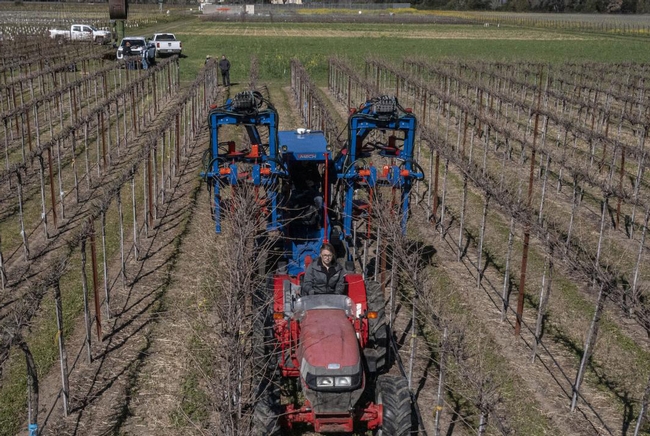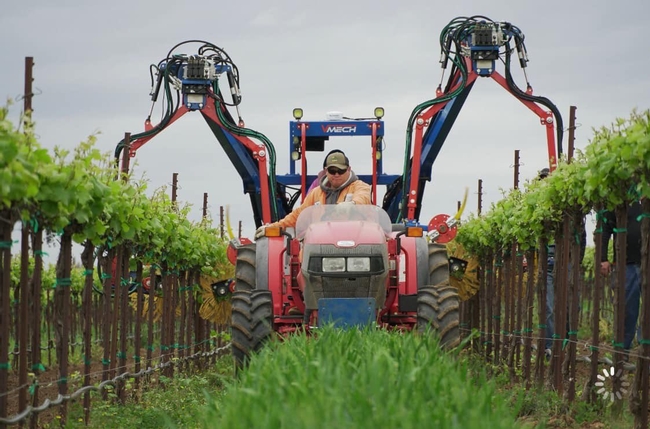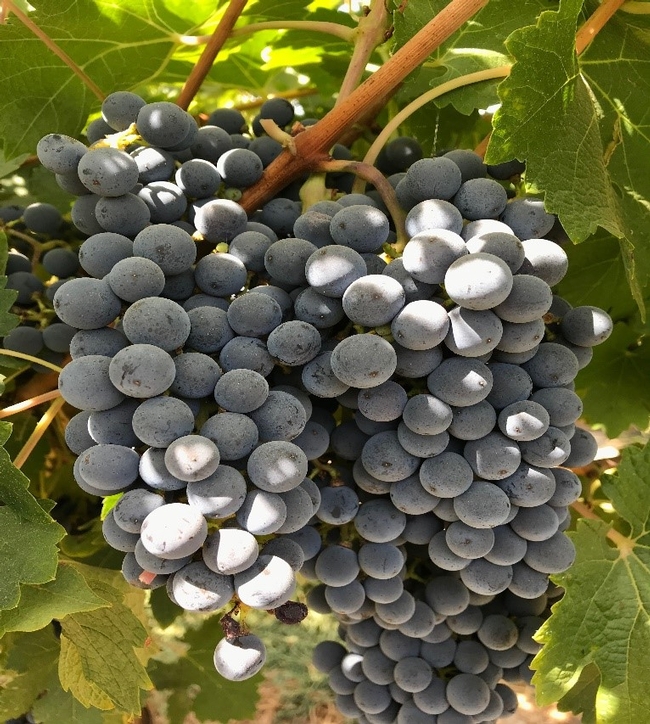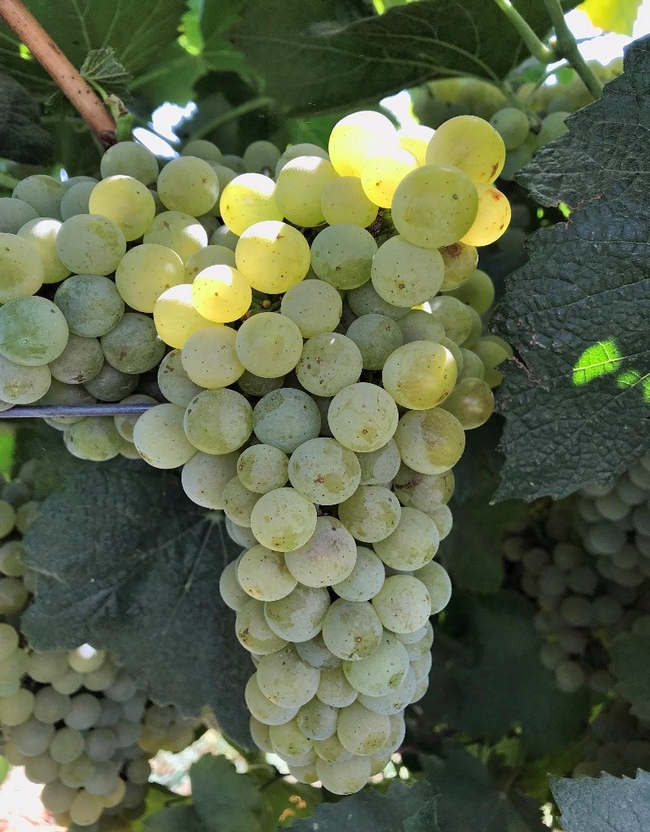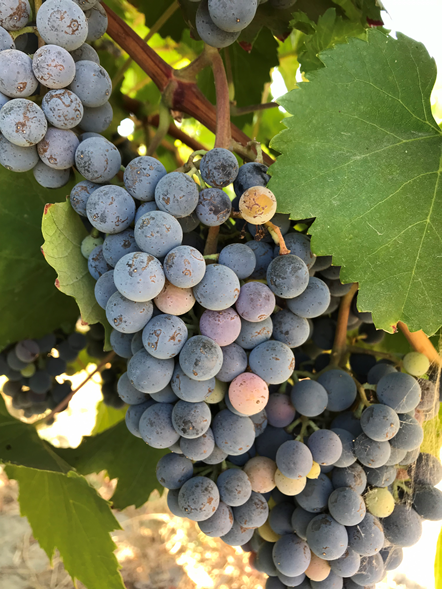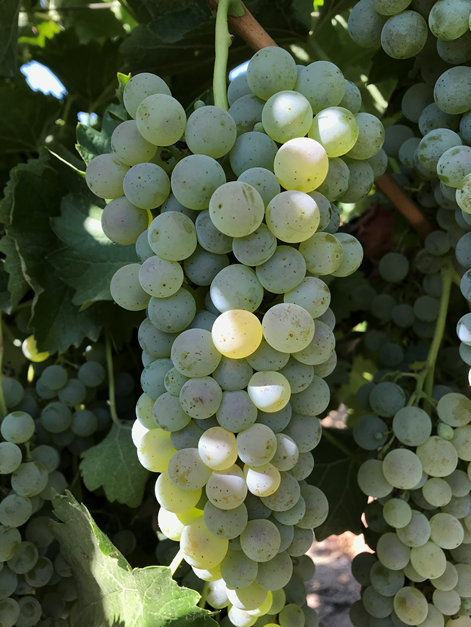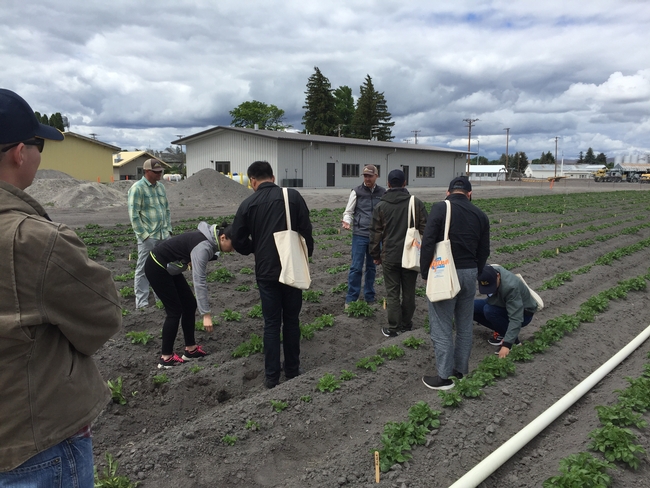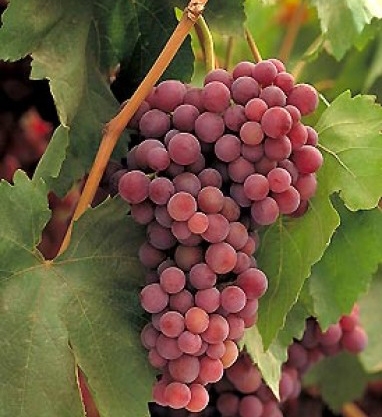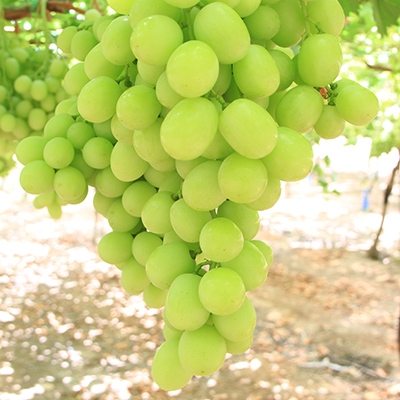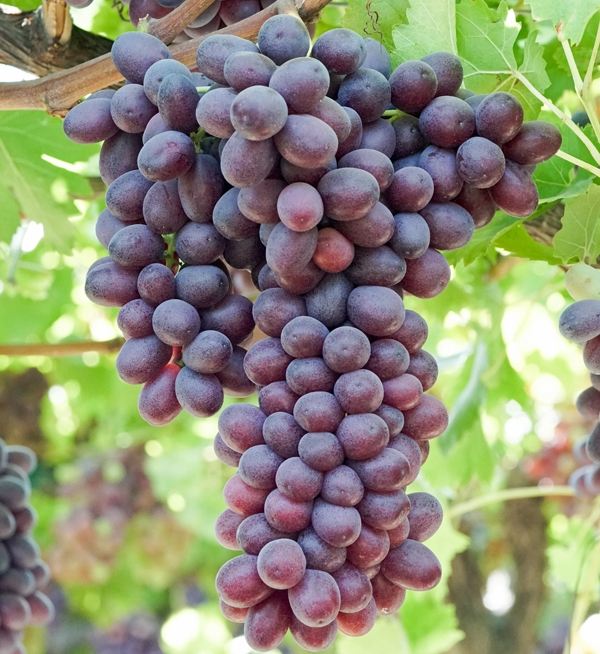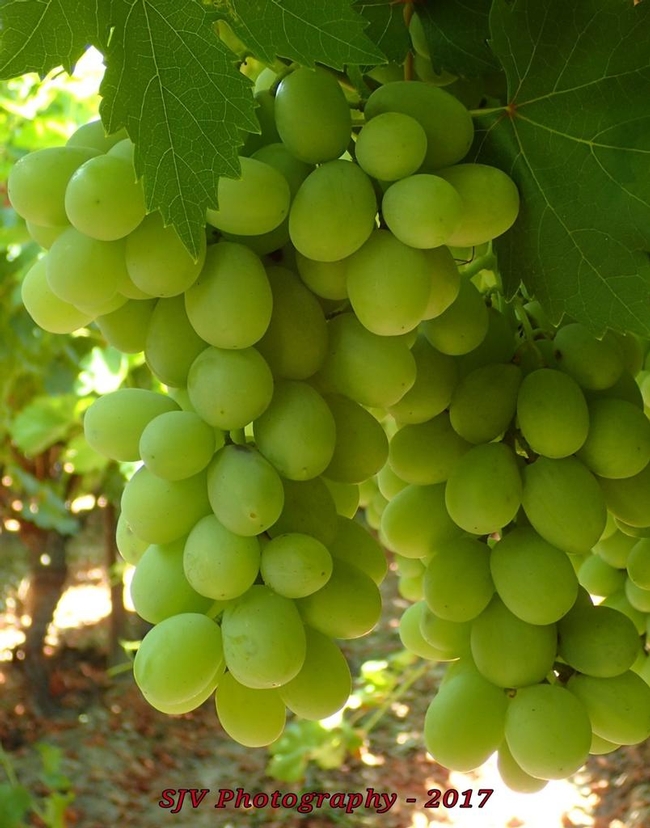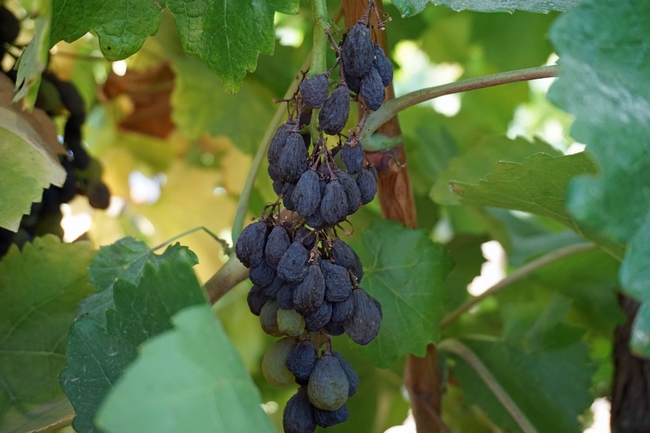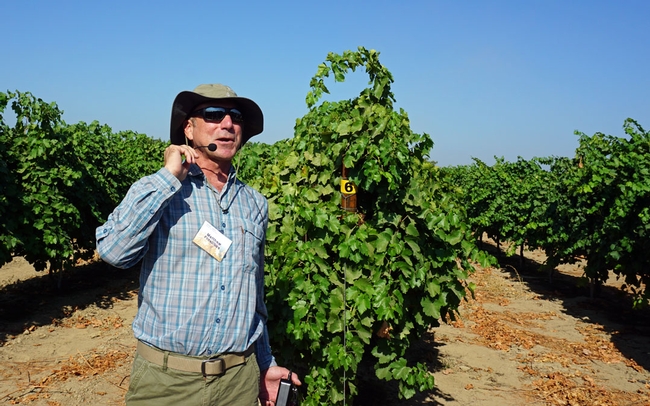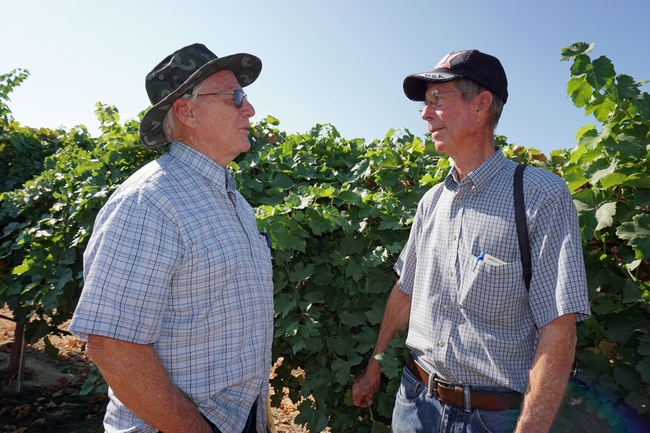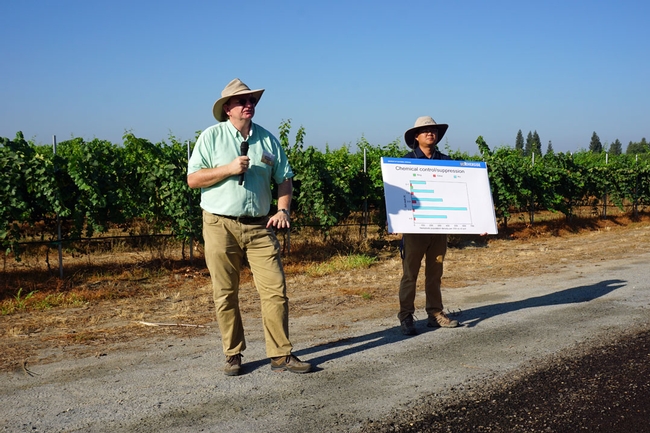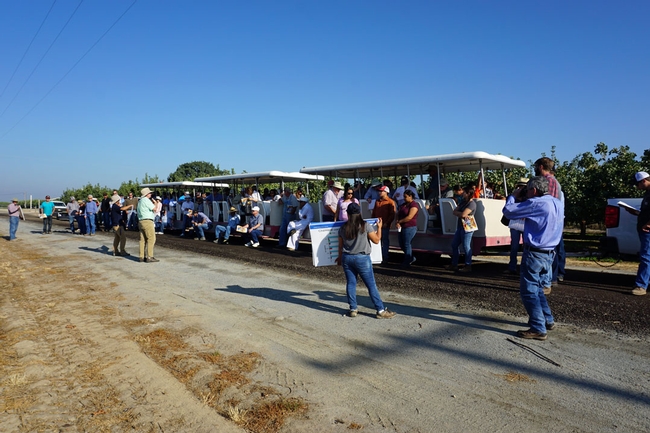Posts Tagged: Matthew Fidelibus
Machines can help wine grape industry survive labor shortage
Wine grape growers in California and elsewhere face increasing labor costs and severe labor shortages, making it difficult to manage and harvest a vineyard while maintaining profitability. Growers are increasingly turning to machines for pruning, canopy management and harvesting, but how well these practices are executed can substantially affect yield and quality. A new review by researchers at the University of California, Davis, published in the journal Catalyst, provides guidelines for growers to make the best use of machines.
“Wine grape laborers have been virtually nonexistent. People don't want to work in vineyards anymore because it's remote, tough work,” said Kaan Kurtural, UC Davis professor of viticulture andenology andUC Cooperative Extension specialist. “There is now machinery available to do everything without touching a vineyard.”
Kurtural has designed a “touchless” experimental vineyard at the UC Davis Oakville Station to help growers understand how machines can help them cope with the labor shortage. While machines reduce the need for seasonal manual labor, they do not eliminate it. The degree of labor reduction depends on growing region, grapevine type and the number of practices growers mechanize.
The review provides guidance on using machines for winter pruning, canopy management and harvesting as well as how to design a grape vineyard for machines before planting. Videos showing the operation of different types of machinery and practices can also be found in the review.
Economic savings, quality grapes
About 90% of the wine grapes crushed in the U.S. are mechanically harvested. Previous studies have found about a 50% savings in labor costs from using machines to harvest instead of hand harvesting.
“Using more mechanization in a vineyard beyond just harvesting can also reduce labor costs without affecting grape quality.” Kurtural said.
Mechanical pruning, for example, can save between 60% to 80% of labor operation costs per acre compared to manual pruning alone. One experiment in the San Joaquin Valley, where more than 50% of California's wine grapes are grown, also showed using mechanical canopy management machines to manage merlot grapes resulted in twice the amount of color. The more color, or higher anthocyanin concentrations, the better the quality. It can significantly improve returns from vineyards in California's heartland.
Kurtural said there are machines available to manage canopies, including machines for leaf removal, shoot thinning and trunk suckering. Kurtural noted that the machines are American made, developed by researchers at the University of Arkansas and commercialized by manufacturers in Fresno and Woodland, California.
The review was co-authored by Matthew Fidelibus, UC Cooperative Extension viticulture specialist at UC Davis, based at UC Kearney Agricultural Research and Extension Center. Financial support for the research came from the American Vineyard Foundation and Bronco Wine Company.
Original post at https://www.ucdavis.edu/news/machines-can-help-wine-grape-industry-survive-labor-shortage.
UC releases new cost studies for mechanized winegrape production
New studies provide details about trellis type, planting density, cost and potential benefit of vineyard mechanization
UC Agriculture and Natural Resources' Agricultural Issues Center has released four new studies detailing the costs and returns of wine grape production in the southern San Joaquin Valley. All four cost studies illustrate the cost and benefit of nearly full mechanization on wine grape production.
The studies estimate the cost of establishing a vineyard and producing wine grapes, focusing on four wine grape varieties – Cabernet Sauvignon, Chardonnay, Rubired and Colombard.
“Those studies take into consideration mechanical pruning, leafing, shoot thinning, and harvest on a typical wine grape vineyard with the average production level for this region,” said George Zhuang, UC Cooperative Extension viticulture advisor in Fresno County.
“With farming labor becoming more scarce and expensive, growers will opt to transition into more mechanization,” Zhuang said. “These studies provide detailed information about the trellis type, planting density, cost and potential benefit of vineyard mechanization. Based on these studies, fully implemented mechanization reduces the production cost from $3,000 to $2,500 per acre and that represents 17% cost reduction. This information will ultimately help growers to guide their production practices to more profitable and competitive ways under the new era of farming labor.”
Wine grape growers should look at the costs, particularly expenses associated with mechanization, Zhuang said.
“The investment to purchase and own equipment can be high,” Zhuang said. “Fortunately, it is easy to find a contractor in this region to perform certain vineyard tasks, if the initial investment to purchase equipment is prohibitive.”
Numerous studies, including UC studies, have confirmed the benefits of vineyard mechanization to grape and wine quality with lower production costs.
“It is a win-win-win situation,” Zhuang said. “Growers can improve their farming margins, wineries and juice processing plants can get reliable and higher quality grapes and juice from farms, and average consumers can enjoy better wine and more healthy grape products at an affordable price.”
The studies are based on 200-acre farms with the vineyard established on 40 acres using two types of trellis systems – quadrilateral cordon system and bilateral cordon system. In addition to regular grape production expenses – such as irrigation, fertilization and pest control – the researchers broke out the differences between machinery costs and hand labor hours required for thinning, pruning and harvesting for each variety.The prices for labor, materials, equipment and custom services are based on October 2019 figures.
The California minimum wage law will gradually decrease the number of hours employees can work on a daily and weekly basis before overtime wages are required. For more information and to view the California minimum wage and overtime phase-in schedules visit aic.ucdavis.edu.
Input and reviews were provided by UC Cooperative Extension farm advisors, specialists, grower cooperators and other agricultural associates. The authors describe the assumptions used to identify current costs for wine grape establishment and production, material inputs, cash and non-cash overhead. A ranging analysis table shows profits over a range of prices and yields.
The new studies are:
- 2019 - Sample Costs to Establish and Produce Winegrapes in the Southern San Joaquin Valley – Chardonnay Variety
- 2019 - Sample Costs to Establish and Produce Winegrapes in the Southern San Joaquin Valley –Cabernet Sauvignon Variety
- 2019 - Sample Costs to Establish and Produce Winegrapes in the Southern San Joaquin Valley – Rubired Variety
- 2019 - Sample Costs to Establish and Produce Winegrapes in the Southern San Joaquin Valley – Colombard Variety
All four winegrape studies can be downloaded from the UC Davis Department of Agricultural and Resource Economics website at http://coststudies.ucdavis.edu. Sample cost of production studies for many other commodities are also available on the website.
For additional information or an explanation of the calculations used in the studies, contact Donald Stewart at the Agricultural Issues Center at (530) 752-4651 or destewart@ucdavis.edu.
For information about local grape production, contact George Zhuang, UCCE viticulture advisor for Fresno County, at gzhuang@ucanr.edu; UCCE viticulture specialist Matt Fidelibus at mwfidelibus@ucanr.edu; UCCE viticulture specialist Kaan Kurtural at skkurtural@ucdavis.edu; Karl Lund, UCCE viticulture advisor for Madera, Merced and Mariposa counties, at ktlund@ucanr.edu; or Gabriel Torres, UCCE viticulture advisor for Kings and Tulare counties, at gabtorres@ucanr.edu.
June 2018 news clips
Agricultural advances draw opposition that blunts innovation
(Science) Anne Q. Hoy, June 29
Scientists are using technology to expand global food production and ease its environmental impact, but advances are being challenged by claims that lack scientific evidence and raise public distrust and concern, a leading agricultural scientist told an American Association for the Advancement of Science audience.
Alison Van Eenennaam traced the advent of campaigns against agricultural innovations related to areas from cattle and chicken production systems to plant biotechnology. The impact such efforts are having on agricultural advances was the focus of the ninth annual AAAS Charles Valentine Riley Memorial Lecture on 5 June at the AAAS headquarters in Washington, D.C.
http://science.sciencemag.org/content/360/6396/1413.full
UC Davis Experts Help Farmers, Ranchers Profit in Growing Trend
(Cal Ag Today) Patrick Cavanaugh, June 29
Many farmers could benefit from agritourism and the added value it brings, but developing successful agritourism operations can be tricky. Experts at the Agricultural Sustainability Institute (ASI) at UC Davis are helping farmers and others in the agricultural community understand the regulations, permits, insurance, marketing and other considerations needed to succeed.
“Agritourism operations are more successful when they're part of a supportive community of tourism professionals, county regulators, agriculture regulations and others,” says Gail Feenstra, ASI's food, and society coordinator.
Feenstra and her team recently received a $73,000 grant from Western Sustainable Agriculture Research and Education, a U.S. Department of Agriculture program, to develop training, resources and peer support for farmers and ranchers considering agritourism. Feenstra is working with Penny Leff, ASI's statewide agritourism coordinator and team project manager.
https://californiaagtoday.com/agritourism-california/
Green thumbs at the Marin County Fair
Wendy Irving, June 29
…UC Marin master gardeners is a group of more than 300 trained volunteers who work as non-paid staff members of the University of California Cooperative Extension. There are master gardener programs in 50 counties across California; our Marin group is one of the largest and most active.
http://www.marinij.com/article/NO/20180629/FEATURES/180629808
Answer to how urban coyotes thrive is not for weak-stomached
(Texarkana Gazette) From the LA Times, June 29
This scientific study is a coyote postmortem on an unprecedented scale—it has so far documented the contents of 104 stomachs and intends to examine 300 by the end of the year. The team, led by Niamh Quinn, UC Cooperative Extension's human-wildlife interactions advisor, is already generating a wealth of data to better understand how these omnivorous canids sample everything from pocket gophers to hiking boots while managing to survive in a land of 20 million people.
Mechanized vineyard saves labor, boosts quality
(Western Farm Press) Tim Hearden, June 27
Kaan Kurtural started working on a fully mechanized vineyard to help growers save on labor costs, but then he noticed it also produced grapes with superior quality.
“We made wine from these last year and compared it to our traditionally-farmed vineyards,” says Kurtural, a specialist in the University of California-Davis Department of Viticulture and Enology. “Until we tell people what it is, they can't distinguish the quality of the fruit or the wine.”
He demonstrated the 40-acre experimental vineyard during a recent field day at the UC-Davis Oakville Station north of Napa. About 200 winegrape growers, vineyard consultants, and other industry representatives attended.
http://www.westernfarmpress.com/grapes/mechanized-vineyard-saves-labor-boosts-quality
Several methods available to control vineyard weeds
(Western Farm Press) Tim Hearden, June 27
As most fumigants in California are being phased out, growers are having to find other ways to control weeds in young vineyards.
And while weeding by hand has been done, increased costs and a shrinking labor force have made this task impractical, says John Roncoroni, University of California Cooperative Extension Weed Science Farm Advisor in Napa County.
http://www.westernfarmpress.com/grapes/several-methods-available-control-vineyard-weeds
New podcast offers advice to California farmers
(Capital Press) Padma Naggapan, June 26
Two enterprising farm advisors with the University of California's cooperative extension have begun a podcast that will focus on tree crops and other produce grown in the Central Valley.
Called “Growing the Valley,” the podcast will have a new episode every two weeks, with each episode focused on news growers can use, such as managing specific pests, irrigation techniques, alerts about what to watch out for, and what tasks to take care of at particular times of the year.
http://www.capitalpress.com/Research/20180626/new-podcast-offers-advice-to-california-farmers
Proactive Pawnee Fire response in Lake County seeks to avoid another catastrophe
(SF Chronicle) Lizzie Johnson, June 25
“I've never seen so much focused attention in Sacramento on the issue,” said Keith Gilless, a professor of forest economics and dean of the College of Natural Resources at UC Berkeley.
“Last year, 2017, got everybody's attention,” said Gilless, chair of the California State Board of Forestry and Fire Protection. “Last year was just terrible. Everybody involved is doing their best to be as prepared as we can. Any area might burn now, including those with much higher structure densities than they did 20 or 50 years ago.
“You are going to need a lot of resources that you might not have needed before,” he said. “The state is being very aggressive in its suppression efforts.”
UC's Humiston welcomes visiting Chinese ag scientists
(Farm Press) Jeannette Warnert, June 25
UC Agriculture and Natural Resources vice president Glenda Humiston recently welcomed a delegation of Chinese agricultural scientists to UC ANR's Intermountain Research and Extension Center in Tulelake, reported Danielle Jester in the Siskiyou Daily News.
http://www.westernfarmpress.com/extension/ucs-humiston-welcomes-visiting-chinese-ag-students
With vineyard labor scarce, Napa growers warm up to machines
(Napa Valley Register) Henry Lutz, June 24
On a recent morning at the UC Davis Oakville Experimental Station, extension specialist Dr. Kaan Kurtural walked along the edge of an especially tall block of Cabernet Sauvignon.
Planted in 2016, the block hosts 1,340 vines and produces roughly 15 to 18 pounds of fruit per vine. “So it'll be yielding quite nice,” Kurtural said as he walked down the 62-inch tall rows.
Far more notable than the vineyard's fruit, however, is how it gets farmed.
“There are no hand practices out here,” said Kurtural. “Everything is done by machine.”
Early Detection Key to Managing Ceratocystis Canker in Almonds
(Growing Produce) Dianne Munson, June 22
...Based on a statewide survey out of the Department of Pathology at University of California, Davis, canker diseases are the primary cause of tree death in almond orchards, and Ceratocystis canker is one of the most prevailing canker diseases found in California. This canker disease is aggressive, but it doesn't have to mean disaster.
“If you know what to look for, the disease is manageable,” says Florent Trouillas, UC Cooperative Extension Specialist, Department of Plant Pathology, University of California, Davis.
California has 27M more dead trees than in 2016, but numbers may be easing in some areas
(Ventura County Star) Cheri Carlson, June 22
“Trees aren't getting moisture that they need to be healthy and they're stressed,” said Susan Kocher, a natural resources adviser for UC Cooperative Extension. “We had a huge insect outbreak because of the drought.”
Kocher, based in South Lake Tahoe, focuses on the Central Sierra, where stands of ponderosa pines were hit hard by beetle attacks.
…The highest risk of fire is when trees still have their needles – the so-called “red and dead” phase, Kocher said. Green needles turn red, and those dried-out needles are a particularly flashy fuel, like tinder in a campfire. Once the needles fall off, the risk drops a bit.
Chinese scientists visit Tulelake
(Siskiyou Daily News) Danielle Jester, June 20
The University of California Agriculture and Natural Resources Intermountain Research and Extension Center in Tulelake hosted a group of scientists from Chinese universities on Sunday; the scientists are on a tour of agriculture in northern California through June 22.
University of California Vice President of Agriculture and Natural Resources Glenda Humiston explained the purpose of the tour, noting, “The Chinese face many of the same issues that we do here in the U.S. The Chinese universities want to improve rural economic development to lift up the quality of life for people in rural communities.
“They are also responding to global climate change, drought and pests while trying to improve food security and water use efficiency. They see UC Cooperative Extension as an effective research model; we hope that scientific collaborations will accelerate solutions and help maintain relations for California agriculture with China.”
http://www.siskiyoudaily.com/news/20180620/chinese-scientists-visit-tulelake
It's summer. Here's how to preserve those fresh fruits and veggies
(San Luis Obispo Tribune) Rosemary Orr, June 20
June in San Luis Obispo County is a wonderful time to start preserving our summer bounty of fruits and vegetables.
The UCCE Master Food Preservers will teach the basic principles of food preservation and canning in its Introduction to Canning class on Saturday.
https://www.sanluisobispo.com/living/home-garden/article212766254.html
With wildfire season at hand, California on slightly safer footing this year
(SF Chronicle) Kurtis Alexander, June 17
… But as significant, and plentiful, as the new fire-protection measures are, they merely nip at the edge of an underlying issue: that fire is a constant in California, and as long as people choose to live in and around the state's wildlands, experts say, the threat remains.
"I would not be surprised if we have another big fire," said Bill Stewart, forestry specialist at the University of California, Berkeley. "I just don't think we're where we need to be."
… “We really haven't put together the pieces of a resilient fire strategy in local areas,” Stewart said.
https://www.sfchronicle.com/news/article/With-wildfire-season-at-hand-state-on-slightly-13000782.php
Reducing food waste to combat world hunger
(Morning Ag Clips) June 17
One-third of the world's food is spoiled or tossed rather than eaten, a fact that is tragic when nearly one billion people go hungry. The injustice of food waste is worsened by the fact that food decomposing in landfills emits greenhouse gases that contribute to climate change.
UC Cooperative Extension is working closely with the cities and county of Santa Clara in a far-reaching program to divert organic matter – food and green waste – from landfills by composting and using the product to enrich soil in the home garden.
https://www.morningagclips.com/reducing-food-waste-to-combat-world-hunger/
From dendrometers to drones, devices drive ag-tech boom
(Farm Press) Tim Hearden, June 16
Agriculture across the country is going high-tech, and California is leading the way as the tree nut and other industries are looking for ways to save water.
Agriculture across the country is going high-tech, as the ag and food sectors invested $10.1 billion in digital technologies in 2017, according to a University of California study. That's up from $3.2 billion in 2016, reports the UC's Giannini Foundation for Agricultural Economics.
In California, which was the leading state last year with $2.2 billion spent to adopt new technologies in ag and food production, UC Cooperative Extension researchers are researching or developing lots of new, innovative ideas. And growers are putting them to work in their fields and orchards.
http://www.westernfarmpress.com/technology/dendrometers-drones-devices-drive-ag-tech-boom
Santa Barbara County Avocado Farmer Struggles to Find Workers Amid Immigration Crackdown
(CNN Money/KTLA) Kristen Holmes, June 15
…“The crops that are most affected are the ones that use hired labor,” explains Daniel Sumner, director of the University of California, Agricultural Issues Center at UC Davis, pointing to avocados, berries and tree fruits. “It's really now through the rest of the summer that we're going to hear more and more farmers and farm workers rushing to get a harvest in with really not enough labor force to do it. And that's a real challenge. It may mean that we have crops rotting in the fields.”
http://money.cnn.com/2018/06/15/news/economy/california-farmer-workers-immigration/index.html
http://ktla.com/2018/06/15/santa-barbara-county-avocado-farmer-struggles-to-find-workers-amid-immigration-crackdown/amp
Research Nets Going Over Citrus Trees To Prevent Huanglongbing Disease
(Cal Ag Today) Jessica Theisman, June 15
Beth Grafton-Cardwell is the director of the Lindcove Research Extension Center in Tulare County and research entomologist based out of the University of California, Riverside. She recently told California Ag Today that there is work being done on installing a net structure to protect trees from Asian Citrus Psyllids, which spread the deadly Huanglongbing disease. Texas A&M researchers are installing net structures on the edge of groves to block psyllids from coming into an orchard.
https://californiaagtoday.com/research-nets-going-citrus-trees-prevent-huanglongbing-disease/
Overburdened growers fuel an ag-tech investment boom
(Western Farm Press) Tim Hearden, June 14
…While ag was slower than some other industries at adopting digital technologies, farm and food sector investments in these technologies zoomed to $10.1 billion nationwide last year, up from $3.2 billion in 2016, according to a new University of California report.
California was the leading state for ag-tech investments with $2.2 billion in 2017, or 22 percent of the total, and ag and food producers in the Golden State spent $5.1 billion on new technologies between 2012 and 2017, reports the UC Giannini Foundation for Agricultural Economics.
http://www.westernfarmpress.com/technology/overburdened-growers-fuel-ag-tech-investment-boom
UCD Oakville Field Day Highlights: Trellis Trials, Red Blotch Vector Update, Mechanization Tools
(Wine Business) Ted Rieger, June 12
The University of California, Davis (UCD) hosted its annual Grape Day at the Oakville Station experimental vineyard in Napa Valley June 6 with talks and presentations by UC Cooperative Extension specialists, and presentations and equipment demos from vineyard industry suppliers.
UCD viticulture extension specialist Dr. Kaan Kurtural showed a trial planted in 2016 with six different trellis systems designed for mechanical harvest in a 1-acre block at the experimental vineyard using Cabernet Sauvignon 08 on 3309 rootstock. The six trellis types include: a traditional vertical-shoot- positioned (VSP) trellis as a control; a single high-wire system designed for mechanized management; a high-quad system; a cane-pruned system with 12-inch cross arms for a sprawl-type canopy; and two versions of a relaxed VSP, one with a T-top post for a wider canopy.
https://www.winebusiness.com/news/?go=getArticle&dataId=199959
Local groups offer water measurement course
(Siskiyou Daily News) June 12
The Siskiyou County Cattlemen, Siskiyou County Farm Bureau and University of California, Cooperative Extension will sponsor a Water Measurement and Reporting Course in order to comply with Senate Bill 88.
http://www.siskiyoudaily.com/news/20180612/local-groups-offer-water-measurement-course
New Potato Varieties Displayed at Field Day in Kern County
(AgNet West) Brian German, June 11
Dozens of industry professionals took part in the annual Kern County Potato Variety Field Day where attendees got an opportunity to view new potato varieties and see the progress of ongoing growing trials.
“The potato field day in Kern County has a long history, it's been going on for generations essentially,” said Farm Advisor Emeritus with Kern County Cooperative Extension Joe Nunez. “It's an opportunity for the growers to see all the new varieties that are being developed throughout the country and see how they perform here in Kern County because our growing conditions here are a little bit different than where most of the potato varieties are being developed.”
http://agnetwest.com/new-potato-varieties-field-day-kern-county/
Debating California Tillage
(Farm Equipment) Alan Stenum, June 9
Despite differing opinions, Alan Wilcox, of Wilcox Agri-Products and Jeff Mitchell, no-till advocate at University of California–Davis, sat down during World Ag Expo in Tulare, Calif., to discuss the challenges and the opportunities for conservation tillage practices to take hold in California's Central Valley.
https://www.farm-equipment.com/articles/15683-debating-california-tillage
Letter: Residents get primer on fire preparedness
(Chico Enterprise-Record) Calli-Jane DeAnda, June 8
May was wildfire awareness month and the community participated in the wildfire safety fair at Lake Oroville Visitor Center on Saturday, May 19. At this fantastic event community members were able to get information about how to sign up for emergency notifications, access the evacuation preparedness plan, get wildfire recovery information and get tips for protecting homes from wildfire.
Kate Wilkin, UC Cooperative Extension, provided two presentations on prescribed fire and ways to protect homes from wildfire. Local fire-safe councils were there to answer the question: What does a fire-safe council do?
https://www.chicoer.com/2018/06/07/letter-residents-get-primer-on-fire-preparedness/
Why a Decline in Insects Should Bug You
(Wall Street Journal) Jo Craven McGinty, June 8
Entomologists want to put a bug in your ear: Insects are necessary for the survival of mankind.
“It's the classic third-grade food chain,” said Richard Redak, an entomologist at the University of California, Riverside, and co-author of the book “Bugs Rule!” “If you pull insects out, you've got a problem.”
…“Any organic product in a human's life probably has a beneficial insect and a pesty insect,” Dr. Redak said. “The pesty ones are an incredibly small fraction of the total. Those that are not a problem are critical to the ecosystem.”
https://www.wsj.com/articles/why-a-decline-in-insects-should-bug-you-1528467502
Brown Marmorated Stink Bug Officially Deemed Pest of California Almonds
(Growing Produce) David Eddy, June 7
Brown marmorated stink bug (BMSB) is certainly not new to California growers, but in the wake of some more troubling finds, it is now officially a pest of almonds.
Almonds are now listed as a preferred host on the Stop BMSB website, which was created by a team of researchers from all over the country dedicated to finding a way to stop the pest from damaging a wide range of crops.
One of those researchers is Jhalendra Rijal, University of California Cooperative Extension Area IPM Advisor for San Joaquin, Stanislaus, and Merced counties, who said the first such damage was just two years ago, when they were found in peaches. The actual first finding in the state was three years before that, in Sacramento, but despite being a very large find, they never appeared to spread, adding to the mystery of BMSB movement.
Visible smoke coming from UC field station burn
(The Union) June 7
Nevada County residents wondering why there is smoke in the air coming from our neighbors to the west today may be seeing smoke from a live fire training held by the University of California Cooperative and Extension at a field station in Browns Valley, according to Cal Fire spokesperson Mary Eldridge.
https://www.theunion.com/news/visible-smoke-coming-from-uc-field-station-burn/
UCCE advisors launch 'Growing the Valley' podcast
(Farm Press) Jeannette Warnert, June 5
A new UC Cooperative Extension podcast that focuses on growing orchard crops in the San Joaquin and Sacramento valleys is now available free at http://growingthevalleypodcast.com, Apple iTunes and Google Play Music.
The hosts are Phoebe Gordon, UCCE orchard systems advisor in Madera and Merced counties, and Luke Milliron, UCCE orchard systems advisor for Butte, Tehama and Glenn counties. The pair conduct research and extension programs that cover tree crops, with a focus on almonds, pistachios, walnuts, prunes, figs and cling peaches.
http://www.westernfarmpress.com/extension/ucce-advisors-launch-growing-valley-podcast
7 Highlights from the 2018 World Meat Congress
(Pork) U.S. Meat Export Federation, June 4
The 2018 World Meat Congress concluded Friday with sessions focused on consumer trends and education, as well as an in-depth look at cutting-edge technologies reshaping meat production around the world. The 22nd World Meat Congress was held in Dallas May 31 and June 1. Hosted by the U.S. Meat Export Federation (USMEF) and the International Meat Secretariat (IMS), the event drew about 700 participants from more than 40 countries.
…The panel featured Gary Rodrigue, blockchain food trust leader for the IBM Corporation; Dr. Martin Wiedmann, Gellert family professor in food safety at Cornell University; and Dr. Alison Van Eenennaam, cooperative extension specialist for animal genomics and biotechnology at the University of California-Davis.
… Van Eenennaam, whose program at UC-Davis focuses on research and education around the use of animal genomics and biotechnology in livestock production systems, explained the value of gene editing. For example, research is underway to utilize gene editing to prevent such diseases as African swine fever in hogs and tuberculosis in cattle.
“What better way to approach dealing with disease than through genetic improvement?” she noted.
https://www.porkbusiness.com/article/7-highlights-2018-world-meat-congress
Use of gene editing to introduce the polled trait into elite germplasm
(Progressive Dairyman) Alison L. Van Eenennaam and Maci L. Mueller, June 4
Physical dehorning of dairy cattle is a standard practice to protect both human dairy workers and other animals from injury. However, it is not only costly for producers, but also painful and stressful for the animals. As a result, dehorning is currently facing increased public scrutiny as an animal welfare issue. Despite these factors, 94 percent of U.S. dairy cattle producers report routine dehorning.
Early Ripening Grapes Could Revolutionize Raisin Production
(Growing Produce) Matthew Fidelibus, June 2, 2018
The USDA-ARS raisin grape breeding program has long focused on the development of early ripening varieties. Early ripening allows drying to begin sooner, thus helping to avoid inclement weather and enable production of dry-on-vine (DOV) raisins. ‘Fiesta' and ‘Selma Pete' are examples of early ripening raisin grapes from the USDA that have helped change the way California raisins are made.
http://www.growingproduce.com/fruits/grapes/early-ripening-grapes-revolutionize-raisin-production
New labor laws factored into UC cost studies for table grape production
To help table grape growers make decisions on which varieties to grow, the UC Agriculture and Natural Resources' Agricultural Issues Center has released four new studies on the costs and returns of table grapes in the Southern San Joaquin Valley. The studies on different table grape varieties are each based on a 500-acre farm with vineyard establishment on 40 acres.
The studies focus on four table grape varieties. There are two early maturing varieties, Flame Seedless and Sheegene-21, that begin harvest in July, one mid-season maturing, Scarlet Royal, and one late maturing, Autumn King, which begins harvest in October. The studies estimate the cost of establishing a table grape vineyard and producing fresh market table grapes.
“Labor costs are expected to rise with reduced labor availability, increases in minimum wage rates and new overtime rules that went into effect in 2018,” said Ashraf El-kereamy, UCCE viticulture advisor in Kern County and co-author of the cost studies.
“We included detailed costs for specialized hand labor of certain cultural and harvest operations.”
The sample costs for labor, materials, equipment and custom services are based on January 2018 figures. A blank column, titled “Your Cost,” is provided in Tables 2 and 3 for growers to enter their own estimated costs.
“The new California minimum wage law will gradually decrease the number of hours employees can work on a daily and weekly basis before overtime wages are required. There are additional stipulations for overtime wages and scheduling of work that are part of the new law,” said Daniel Sumner, director of the Agricultural Issues Center.
Input and reviews were provided by UC ANR Cooperative Extension farm advisors, specialists, grower cooperators, California Table Grape Commission and other agricultural associates. The authors describe the assumptions used to identify current costs for table grape establishment and production, material inputs, cash and non-cash overhead. A ranging analysis table shows profits over a range of prices and yields. Other tables show the monthly cash costs, the costs and returns per acre, hourly equipment costs, and the whole farm annual equipment, investment and business overhead costs.
The new studies are:
- “2018 - Sample Costs to Establish and Produce Table Grapes in the Southern San Joaquin Valley – Flame Seedless, Early Maturing”
- “2018 - Sample Costs to Establish and Produce Table Grapes in the Southern San Joaquin Valley – Sheegene-21 (Ivory™), Early Maturing”
- “2018 - Sample Costs to Establish and Produce Table Grapes in the Southern San Joaquin Valley – Scarlet Royal, Mid-season Maturing”
- “2018 - Sample Costs to Establish and Produce Table Grapes in the Southern San Joaquin Valley – Autumn King, Late Maturing”
All four table grape studies can be downloaded from the UC Davis Department of Agricultural and Resource Economics website at http://coststudies.ucdavis.edu. Sample cost of production studies for many other commodities are also available at the website.
For additional information or an explanation of the calculations used in the studies, contact Donald Stewart at the Agricultural Issues Center at (530) 752-4651 or destewart@ucdavis.edu.
For information about local table grape production, contact UC Cooperative Extension viticulture specialist Matthew Fidelibus at mwfidelibus@ucanr.edu, UCCE viticulture advisor Ashraf El-kereamy in Kern County at aelkereamy@ucanr.edu, UCCE entomology advisor David Haviland in Kern County at dhaviland@ucdavis.edu, UCCE weed advisor Kurt Hembree in Fresno County at kjhembree@ucanr.edu, or UCCE viticulture advisor George Zhuang in Fresno County at gzhuang@ucanr.edu.
Sunpreme raisins a hit at the UC Kearney Grape Day 2017
Excitement over the new Sunpreme raisins was evident at UC Kearney Grape Day Aug. 8, 2017. As soon as the tram stopped, dozens of farmers and other industry professionals rushed over to the vineyard to take a close look and sample the fruit. Raisins pulled from the vine were meaty with very little residual seed. The flavor was a deep, sweet floral with a muscat note.
Sunpreme raisins, bred by now-retired USDA breeder David Ramming, promise a nearly labor-free raisin production system. Traditionally, raisins are picked and placed on paper trays on the vineyard floor to dry. The development of dried-on-the-vine varieties opened the door to greater mechanization. Workers would cut the stems above clusters of grapes, which then dry out in the canopy and are harvested mechanically. The new wrinkle with Sunpreme is that grapes ripen and then start to dry on their own - no cane cutting needed.
UC Cooperative Extension viticulture specialist Matthew Fidelibus and UCCE viticulture advisor George Zhuang are now studying the performance of Sunpreme grapes on different rootstocks and trellis systems at the UC Kearney Agricultural Research and Extension Center.
"We didn't know a lot about this variety," Fidelibus said. "We've found it to be very vigorous."
Fidelibus said the raisins take about a month to dry, and one challenge is the tendency for dried raisins to drop off the vine.
"We want to keep the self drying and stop self dropping," he said.
Ramming discovered the Sunpreme variety in a Thompson seedless table grape variety trial in the mid-1990s. He was going down the row, saw clusters of raisins and screeched to a stop. He had discovered Sunpreme. The variety is not yet available for commercial production.
Fighting nematodes with new solutions
Also during Grape Day 2017, UC Cooperative Extension nemotology specialist Andreas Westphal outlined research underway to keep nematodes at bay.
"There's no methyl bromide in commercial planting," Westphal said. The very effective fumigant was banned because of it's tendency to deplete ozone in the atmosphere and the risk to human health because of its toxicity. Many farmers have turned to Telone as an alternative, however it is expensive and its use is limited by a township cap.
Westphal is comparing alternative treatments for clearing the soil of the tiny worms that feed on vine roots and inhibit vineyard productivity.
"Some companies are coming up with new chemistry," Westphal said. "Our challenge in the perennial world is that the roots go so deep."
Seven new products and Telon were drenched in different replicated research plots. Some areas were left alone to serve as control. Three times the number of Sauvignon Blanc vines were planted in the plots compared to a typical vineyard so researchers could take out plants twice and examine the roots for evidence of pests.
"We are excited to see significant growth differences among the treatments," Westphal said, pointing out a row that was visibly shorter and less vigorous. "It amazed me. Three years after treatment, and it never grew back out of it."
Work is still ongoing, but Westphal said he believes some chemical treatment could be available in the future to help reduce nematode pressure.
To deal with nematode populations, Westphal encouraged growers to sample soil and communicate with the diagnostic laboratory to determine what pest nematodes are in their vineyards, and then use that information for root stock selection.
"Growers should not forget the value of nematode-resistant rootstocks," he said. "Plant material needs to be chosen very carefully when different species of nematodes are present."

